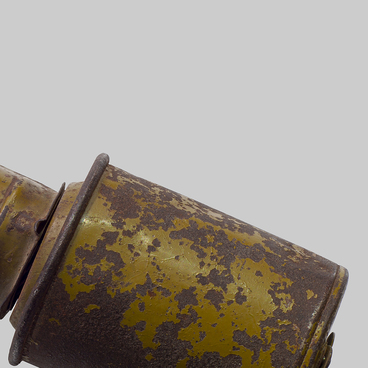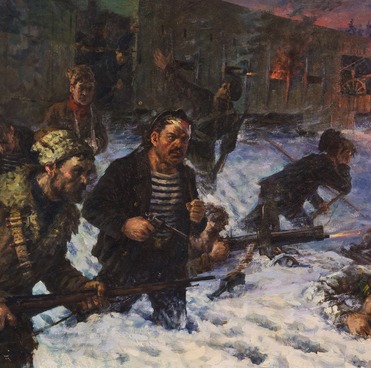The BereznikI Chemical Integrated Plant became one of the largest construction projects in the course of implementing the first five-year plan of the USSR. More than eight thousand people from all over the country were involved in the construction. A new settlement, BereznikI, was constructed to accommodate builders near the plant. The settlement was founded in the vicinity of ChurtAn town and ZhdAnovo village.
The photo album represents the construction period and the first years of the settlement life, and contains 150 photos in total. The album was donated to the museum by DmItry MArin in 1959, a senior engineer of the Housing Construction Authority, who was among the first builders of BereznikI.
The settlement project development envisaged that the population would count 20 thousand people. In 1928, the North Chemical Construction Authority laid the foundations for the first four three-storey buildings, 12 apartments each, to be constructed of red and white bricks. A year later, other 14 houses of the same type were built. 22 wooden houses were built from 1929 to 1933 in the vicinity of ZhdAnovo village.
The stone houses with single-family apartments (two or three-room ones) and dormitories with separate rooms without kitchens were constructed near ChurtAn. The first occupants of these houses were political prisoners who were sent here to construct the chemical integrated plant. VarlAm ShalAmov wrote in his memoirs: ‘Throughout the winter of 1929-30, the prisoners were making liveable the stone boxes erected by civilian contractors in the Town of Light, in ChurtAn. They slept in the damp board beds, or even on the floor side by side. Thousands, dozens of thousands of people involved in constructing the Town of Light worked at the integrated plant and erected a camp for themselves nearby, on the AdAmov Mountain’.
There was no general layout of the town by the commencement of the construction. The first design documents were developed only in 1935. The houses were being built simultaneously in a number of streets. As other towns proposed by the first five-year plans, BereznikI streets were named to honour the socialism achievements along with leaders and heroes of the Russian Civil War. Thus, Industrialization, PyatilEtkа (5-year plan), BereznikOvskaya, ChelYUskintsу Streets occurred together with Construction Workers (StroIteley) Side Street that was renamed later on as ArduAnovsky Side Street after MirsaId ArduAnov who was among the first builders of the town.
BereznikOvskaya Street was the main street of the town in the 30s. There were shops, a bank, a club, a post office, and a kitchen factory (a large mechanized enterprise of food service in the Soviet Union). Most of the population of the town being under construction lived in this street. It was a favourite place for young people’s evening walks.
Judging from the modern point of view, BereznikI looked quite bizarre at that time. Before the planting began, there were only poles with lanterns along the roadways. Some streets were simply covered with sand, and wheeled vehicles and carts were stuck in the sand over and over again. Since the first town residents were mainly former peasants the houses alternated with the barns to keep firewood and pets and with the plots of land to plant potato.
The construction of the first public buildings was started in 1929-1930. They include a bakery, a kitchen factory, a chemical technical college, a bath and laundry, a hospital, a telegraph office, school No. 1 named after Alexander Pushkin. The president of Russia Boris Yeltsin studied in the school in 1940s.
The photo album represents the construction period and the first years of the settlement life, and contains 150 photos in total. The album was donated to the museum by DmItry MArin in 1959, a senior engineer of the Housing Construction Authority, who was among the first builders of BereznikI.
The settlement project development envisaged that the population would count 20 thousand people. In 1928, the North Chemical Construction Authority laid the foundations for the first four three-storey buildings, 12 apartments each, to be constructed of red and white bricks. A year later, other 14 houses of the same type were built. 22 wooden houses were built from 1929 to 1933 in the vicinity of ZhdAnovo village.
The stone houses with single-family apartments (two or three-room ones) and dormitories with separate rooms without kitchens were constructed near ChurtAn. The first occupants of these houses were political prisoners who were sent here to construct the chemical integrated plant. VarlAm ShalAmov wrote in his memoirs: ‘Throughout the winter of 1929-30, the prisoners were making liveable the stone boxes erected by civilian contractors in the Town of Light, in ChurtAn. They slept in the damp board beds, or even on the floor side by side. Thousands, dozens of thousands of people involved in constructing the Town of Light worked at the integrated plant and erected a camp for themselves nearby, on the AdAmov Mountain’.
There was no general layout of the town by the commencement of the construction. The first design documents were developed only in 1935. The houses were being built simultaneously in a number of streets. As other towns proposed by the first five-year plans, BereznikI streets were named to honour the socialism achievements along with leaders and heroes of the Russian Civil War. Thus, Industrialization, PyatilEtkа (5-year plan), BereznikOvskaya, ChelYUskintsу Streets occurred together with Construction Workers (StroIteley) Side Street that was renamed later on as ArduAnovsky Side Street after MirsaId ArduAnov who was among the first builders of the town.
BereznikOvskaya Street was the main street of the town in the 30s. There were shops, a bank, a club, a post office, and a kitchen factory (a large mechanized enterprise of food service in the Soviet Union). Most of the population of the town being under construction lived in this street. It was a favourite place for young people’s evening walks.
Judging from the modern point of view, BereznikI looked quite bizarre at that time. Before the planting began, there were only poles with lanterns along the roadways. Some streets were simply covered with sand, and wheeled vehicles and carts were stuck in the sand over and over again. Since the first town residents were mainly former peasants the houses alternated with the barns to keep firewood and pets and with the plots of land to plant potato.
The construction of the first public buildings was started in 1929-1930. They include a bakery, a kitchen factory, a chemical technical college, a bath and laundry, a hospital, a telegraph office, school No. 1 named after Alexander Pushkin. The president of Russia Boris Yeltsin studied in the school in 1940s.



